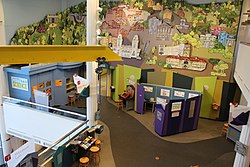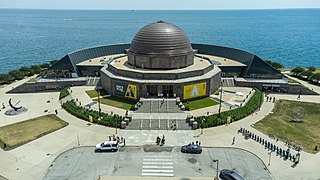
The Adler Planetarium is a public museum in Chicago, Illinois, dedicated to astronomy and astrophysics. It was founded in 1930 by local businessman Max Adler. Located on the northeastern tip of Northerly Island on Lake Michigan, the Adler Planetarium was the first planetarium in the United States. It is part of Chicago's Museum Campus, which includes the John G. Shedd Aquarium and The Field Museum. The Planetarium's mission is to inspire exploration and understanding of the universe.
The Oregon Museum of Science and Industry is a science and technology museum in Portland, Oregon, United States. It contains three auditoriums, including a large-screen theatre, planetarium, and exhibition halls with a variety of hands-on permanent exhibits focused on natural sciences, industry, and technology. Transient exhibits span a wider range of disciplines.

Stardome Observatory & Planetarium is a public astronomical observatory and planetarium situated in Maungakiekie/One Tree Hill Domain in Auckland, New Zealand.

The Cleveland Museum of Natural History is a natural history museum located approximately five miles (8 km) east of downtown Cleveland, Ohio in University Circle, a 550-acre concentration of educational, cultural and medical institutions. The museum was established in 1920 by Cyrus S. Eaton to perform research, education and development of collections in the fields of anthropology, archaeology, astronomy, botany, geology, paleontology, wildlife biology, and zoology. The museum traces its roots to the Ark, formed in 1836 on Cleveland's Public Square by William Case, the Academy of Natural Science formed by William Case and Jared Potter Kirtland, and the Kirtland Society of Natural History, founded in 1869 and reinvigorated in 1922 by the trustees of the Cleveland Museum of Natural History.
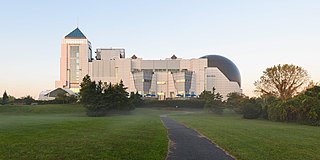
Liberty Science Center is an interactive science museum and learning center located in Liberty State Park in Jersey City, New Jersey, United States. At its opening, it was the largest such planetarium in the Western Hemisphere and the world's fourth largest.
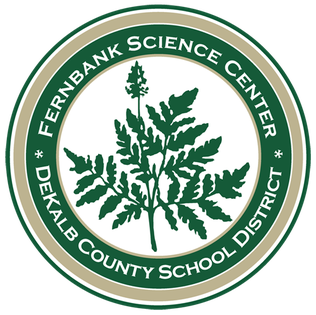
The Fernbank Science Center is a museum, classroom, and woodland complex located in Atlanta. It is owned and operated by the DeKalb County School District, which announced in May 2012 it was considering closing the facility to cut its annual budget, then quickly shelved the plan after public outcry. The nearby Fernbank Museum of Natural History is a private non-profit organization that is separate from the Science Center.

The Carnegie Science Center, soon to be The Daniel G. and Carole L. Kamin Science Center, is one of the four Carnegie Museums of Pittsburgh, Pennsylvania. It is located in the Chateau neighborhood. It is located across the street from Acrisure Stadium.

The Saint Louis Science Center, founded as a planetarium in 1963, is a collection of buildings including a science museum and planetarium in St. Louis, Missouri, on the southeastern corner of Forest Park. With over 750 exhibits in a complex of over 300,000 square feet (28,000 m2), it is among the largest of its type in the United States.

The Manitoba Museum, previously the Manitoba Museum of Man and Nature, is a human and natural history museum in Winnipeg, Manitoba, as well as the province's largest, not-for-profit centre for heritage and science education.

The Fleet Science Center is a science museum and planetarium in Balboa Park in San Diego, California. Established in 1973, it was the first science museum to combine interactive science exhibits with a planetarium and an IMAX Dome (OMNIMAX) theater, setting the standard that most major science museums follow today. It is located at the east end of the El Prado Drive walkway, next to the Bea Evenson Fountain and plaza in central Balboa Park.

The Phillip and Patricia Frost Museum of Science, formerly known as the Miami Science Museum or Miami Science Museum and Space Transit Planetarium, is a science museum, planetarium, and aquarium located in Miami, Florida, United States. The museum originally opened its Coconut Grove location across from Vizcaya Museum and Gardens in 1960. It relocated to Maurice A. Ferré Park in the downtown area adjacent to the Perez Art Museum Miami in 2017 after the closing of the Coconut Grove location in 2015.

That's Entertainment is a comics and collectibles store in Worcester, Massachusetts.

The Cox Science Center and Aquarium, formerly the South Florida Science Center and Aquarium, is a science museum located in West Palm Beach, Florida. Founded in 1959, the goal of the organization is to open every mind to science through the strategic programming of interactive exhibits and engaging community-based camps and events. The Cox Center has expanded since its creation and now houses over 50 hands-on exhibits, a planetarium, a 3000 square foot aquarium, a miniature golf course, and a large exhibit space that displays a temporary travelling exhibit. The Cox Center is a member of the Association of Science-Technology Centers program, which offers a membership that is redeemable at other ASTC science and technology centers around the world. The Cox Center occupies Dreher Park alongside the Palm Beach Zoo and offers deals for entrance into both facilities.

The Museum of Science & History (MOSH) is a museum in Jacksonville, Florida. It is a private, non-profit institution located on the Southbank Riverwalk, and the city's most visited museum. It specializes in science and local history exhibits. It features a large traveling exhibit that changes quarterly, three floors of permanent and signature exhibits, and the Bryan-Gooding Planetarium.

The Fairbanks Museum & Planetarium is a combination natural science museum, history museum, and planetarium located in St. Johnsbury, Vermont. It was founded in 1890 by businessman, politician, naturalist, and collector Franklin Fairbanks. The museum and its buildings are on the U.S. National Register of Historic Places.

The Eugene Science Center, located in Alton Baker Park in Eugene, Oregon, United States, is a science and technology center for children, families, and school groups. The 10,000-square-foot (930 m2) museum near Autzen Stadium features changing interactive exhibits, planetarium shows, camp programs, special events and other science and technology-related education programs. Eugene Science Center is an independent 501(c)(3) non-profit organization governed by a volunteer board of directors. Its mission is: "To engage children, excite their curiosity, inspire them toward a lifetime love of science, and empower them to use science and technology to improve their communities." Eugene Science Center is the only science museum in Lane County and surrounding counties.

The Worcester Historical Museum, located in downtown Worcester, Massachusetts, was founded in 1875 as the Worcester Society of Antiquity. This museum is the only institution in the area devoted entirely to local history and artifacts. The scope of their collection ranges from colonial to twentieth-century, encompassing manuscripts, textiles, paintings, and ceramics. The museum is made up of permanent and temporary exhibits, a research library, and currently owns and operates the local Salisbury Mansion. The library maintains more than 7,000 titles.

The Worcester Red Sox are a professional minor league baseball team based in Worcester, Massachusetts. Beginning play in 2021, the team is the Triple-A affiliate of the Boston Red Sox, succeeding the Pawtucket Red Sox. The team competes in the International League, known as the Triple-A East for the 2021 season, and plays home games at Polar Park in Worcester, Massachusetts.

Polar Park is a baseball park in Worcester, Massachusetts, serving as the home of the Worcester Red Sox, a Minor League Baseball team competing at the Triple-A level and an affiliate of the Boston Red Sox. Opened for the 2021 Triple-A season, it has a seating capacity of 9,508 people. Polar Beverages, a local beverage company based in Worcester, has retained the naming rights to the ballpark.
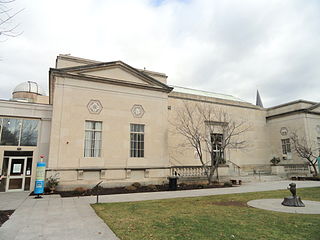
The Springfield Science Museum is located in Springfield, Massachusetts, in the United States. Founded in 1859, the museum has operated in its current building since 1899. The building has undergone two expansions, in 1934 and 1970. It is also home to the country's oldest operating projection planetarium, Seymour Planetarium.
